(完整版)高考总复习名词性从句
语法 名词性从句(高三复习)

但我们常会碰到it用作形式宾语时之后没有形 容词或名词作宾语补足语的情况,这一点在近 几年高考试题中经常涉及,需引起大家的注意
用if 或whether 填空
(是否)
1. I don’t know _w_h_e_t_h_er_/_if_ I’ll be free tomorrow.
2. I don’t knoww_h_e_t_he_ror not I’ll be free tomorrow.
3. The question is _w_h_e_th_erthis book is worth writing.
3. It remains a secret _h__o_w__ they climbed up the
mountain.
主语太长了!放到句尾
注意:主语从句一般位于句首,但有时也 可置于形式主语 it 引导的句子中,位于 谓语动词之后。连词 that 不可省,在从 句中不充当成分,只起连接作用.
(1) It is + 名词 + 从句 It is a fact that … 事实是…
①“wish + 宾语从句”表示不能实现的愿望,译 为“要是……就好了”等。表示现在不能实现的 愿望,从句中的谓语动词用一般过去时;表示将 来不能实现的愿望,从句中的谓语动词用 “would/could + 动词原形”;表示过去不能实现 的愿望,从句中的谓语动词用“had + 过去分词”
②在表示建议、愿望、要求,命令等的动 词suggest、advise、propose、demand、 require、insist request、command、 order等动词后的宾语从句中,从句谓语动 词用(should) + 动词原形或是动词原形。
名词性从句课件-2025届高考英语一轮复习语法专项

下面语篇中含有各种名词性从句,请找出来:
what,which,who
有词意,在从句中做主语,宾语 或表语,不能省略
1 What they want to know is the reason.
Who will attend the meeting is not clear.
2
3 Which side wins makes no difference to him.
宾语
宾语从句
how
在复合句中,主句中的宾语由一 个句子来充当时,该句子就是宾 语从句。
即:宾语不再是一个简单的名词,代词,动 名词或不定式了,而是一个句子。
Read
observe
conclude
We believe that he is honest. 我们相信他是诚实的。
All the teachers think that a positive attitude is import句,就是指用于名词后对该 名词的内容进行说明解释的从句。
The judge paid no attention to the fact that she had just lost her job. Mary suddenly got the feeling that someone was watching her. We are looking forward to the news that we can go home after the mid——term exam. Do you like the idea that we have a picnic in the park at this weekend?
超实用高考英语复习:名词性从句课件

高考质量提升是一项系统工程,涉及到多个方面、各个维度,关键是要抓住 重点、以点带面、全面突破,收到事半功倍的效果。
一、备考策略务必精准
高三备考的不同阶段,目标和任务各不相同,就像打仗一样,攻克不同的 山头有不同的打法,只有抓住要领,才能打赢主动仗。 一是细化“作战地图”
从现在到一模考试前,主要任务是过课本、串教材,把基础知识再夯实, 为专题复习奠定坚实基础。各学科组教师要认真学习新课程、新课标、《中国 考试评价体系及说明》和近三年高考原题,把高考考点和试题变化点做成“作战 地图”,平时考试、练习要对照“作战地图”进行选题,并在“作战地图”上一一标 注,确保考点训练无死角、考点覆盖无遗漏。 二是组织集体攻坚
注意:由what,whatever,whoever等引导的主语从句一般不能用it作形式主语。
表语从句
• 表语从句在句中充当表语,位于主句系动词之后。 The question is who can complete the difficult task.
• 表语从句可用whether引导,也可用as if/though 引导,但不用if引导。 His first question was whether Tom had arrivrd yet. He looked as if he wanted to remember all the things in the room. • 当主句主语是reason时,表语从句的连接词用that而不用because。 区分: That’s why......+结果 That’s because......+原因 The reason why/for...is/was that...
从句,why在从句中充当原因状语。) • Can you find out how to solve the problems?(how 引导介词宾语从句,
高考英语语法专题备考课件-名词性从句

必修三
B.whenever D.whether
英语
高考总复习人教版
(3)在介词之后引导宾语从句时,只用whether。 这样考过
to do ________ it takes to save her life.
A.whichever C.whatever B.however D.whoever
解析:句意:她是我们心爱的宝贝。我们准备不惜一 切代价挽救她的生命。whatever=anything that,连接宾 语从句,兼作takes的宾语。 答案:C
英语
高考总复习人教版
语法专题(五) 名词性从句
必修三
英语
高考总复习人教版
一、引导名词性从句的连接词 1.连接代词和连接副词在句中不是疑问词,从句中
要用陈述语序。
2.连接代词和连接副词在句中充当句子成分;连接
词whether,if,as if在从句中不充当句子成分,只起连接
作用;连接词that在从句中不充当句子成分,且无含义, 有时可省略。
必修三
英语
高考总复习人教版
解析:此处为whether引导的主语从句。
答案:A
必修三
英语
高考总复习人教版
4 . what , which , who , when , where , how 等 与 whatever,whichever,whoever,whenever,wherever,
however等引导名词性从句的区别:
高考英语名词性从句讲解(最全版)
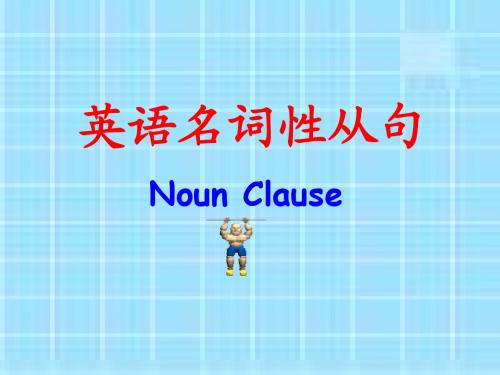
名词性从句引导词的用法(3):
“whoever”-- “-----的任何人”、作主语、 “whomever”-- “-----的任何人”、作宾语、 “whatever”-- “----的任何东西”、作主表宾语、 “whichever”--- “无论哪个或哪些---”、作定语、
连接代词
“whoever”-- “---的任何人”、作主语、起连接作用
(宾语从句)
“whichever”-- “--的哪些或哪个”、作主、表、宾语、
1、Whichever team win the game is possible .
(主语从句)
2、The fact is whichever teacher could help you learn English well . (表语从句) 3、You could choose whichever book you want .
certain (主语从句) .
2、The fact is that Beijing will hold 29th Olympic
Games this year. (表语从句)
3、I know that well begun is half done . (宾语从句) 4、He heard the news that Liuxiang set a new world record .(同位语从句)
“who”---“谁”、作主语、起连接作用 “whom”---“谁”、作宾语、起连接作用
连接代词
“what”---“事情”、作主表宾、起连接作用 “which”---“哪----”、作定语、起连接作用 “whose”---“谁的”、作定语、起连接作用
“who”---“谁”、作主语、起连接作用
专题02 名词性从句(原卷版)(全国通用版)-高考英语复习

专题02 名词性从句I.概念名词在句中一般可以作主语、表语、宾语和同位语等。
1. Water freezes below zero. (作主语)2. Eric was a world famous director. (作表语)3. Would you like some bananas? (作宾语)4. Eric, my English teacher, got promoted last year. (作同位语)相当于名词的从句称为名词性从句,分别称之为主语从句、表语从句、宾语从句和同位语从句。
II. 知识重点与难点一、名词性从句的连接词如下:1.从属连词:that无词义,在从句中不充当成分,在动宾从句中可省略。
whether/ if有词义,但在从句中不充当成分, if 主要用于宾语从句中。
2.连接代词who(ever), whom(ever), whose, what(ever), which(ever) 有词义,在从句中充当成分。
3. 连接副词when, where, why, how 有词义,在从句中充当状语。
二、主语从句:在句子中作主语的从句叫主语从句。
1. 由从属连词引导, 连词本身在从句中不做成分。
That Eric is the most handsome teacher in our school is known to all. (从句作主语,且从句不缺成分,无词义缺失,因此用that。
)Whether he will come or not is not known yet. (从句作主语,从句完整,但缺乏表示“是否”的词,因此用whether。
)2. 由连接代词引导,连词在从句中作主语、宾语、表语和定语。
Who will go remains to be discussed. (从句作主语,who 在主语从句中作主语,表示“某人,谁”。
)What we need is more time. (从句作主语,what 在主语从句中作need 的宾语,表示“东西,什么”。
高中英语高考名词性从句专项复习(知识点+易错点+练习题)

高考英语名词性从句知识点一、that从句1、主语从句that从句作主语时,常用it作形式主语,常见的句型有:It+be+形容词(obvious, true, natural, surprising, good, wonderful, funny, possible, likely, certain, probable, etc. ) + that 从句It+be+名词词组(no wonder, an honor, a good thing, a pity, no surprise, etc. ) + that 从句It+be+过去分词(said, reported, thought, expected, decided, announced, arranged,etc. ) + that 从句that可以省略,但that从句位于句首时,that不能省略。
2、宾语从句(1)常见的可以接that从句作宾语的动词有see, say, know, imagine, discover, believe, tell, show, think, consider, be sure, be afraid 等。
在可以接复合宾语的动词之后,如think, make, consider等,可以用it作形式宾语。
(2)That从句一般不能充当介词宾语,偶尔可作except, in的宾语。
3、表语从句(that不可省略)4、同位语从句连词that引导同位语从句时,应在某些抽象名词之后,如:fact, hope, desire, thought, suggestion, idea, news, problem, possibility 等,对前面的名词起补充说明的作用,that 在从句中不担当任何成分,不能省略。
二、whether/if 从句1>在表语从句和同位语从句中,只能用whether不能用if;当主语从句放于句首时,只能用whether不用if;当it作形式主语,主语从句放在句末时用whether或if均可;discuss后引导宾语从句时,必须用whether。
高三英语总复习课件:语法12名词性从句

Please tell me what you want./Please tell me the thing that you want.(what指物)
○ 请告诉我你想要什么。
○ 他就是人们所知的活字典,因为每个你不认识的字他都认识。
After a long journey, they finally arrived at what is now Boston./After a long journey, they finally arrived at the place that is now Boston.(what指地点)
例 (2010·成都外国语学校模拟)________children watch and learn from the
people around them helps them to figure out how the world works.
○ A.Which
B.That
○ C.How
D.What
这个老师建议学生买这些书。
由具有意义但在从 句中不担当成分的 连词whether或if引 导。
I don't know whether he will go with us or not.
我不知道他是否和 我们一块去。
He asked me whether I would accept him as a new member.
that_running_water_is_pure_and_clean.
我们认为自来水很纯净。
宾语从句也常由it替代,真正的宾语放在句尾。
高考英语复习-名词性从句
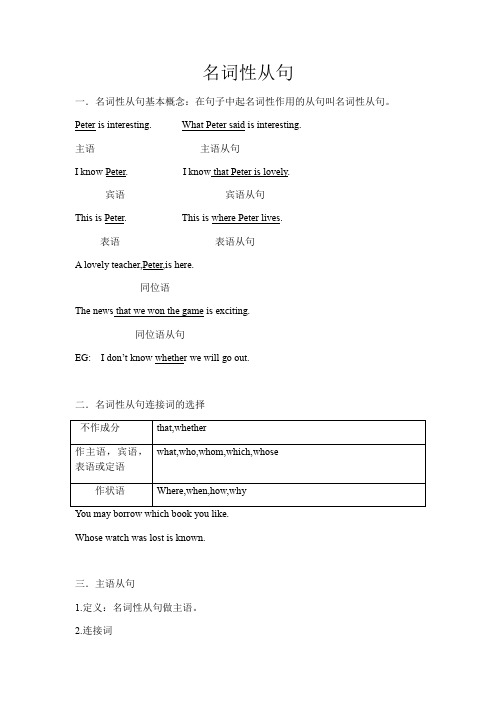
名词性从句一.名词性从句基本概念:在句子中起名词性作用的从句叫名词性从句。
Peter is interesting. What Peter said is interesting.主语主语从句I know Peter. I know that Peter is lovely.宾语宾语从句This is Peter. This is where Peter lives.表语表语从句A lovely teacher,Peter,is here.同位语The news that we won the game is exciting.同位语从句EG: I don’t know whether we will go out.二.名词性从句连接词的选择You may borrow which book you like.Whose watch was lost is known.三.主语从句1.定义:名词性从句做主语。
2.连接词That the earth moves around the sun is known to all.Whether we will go picnicing tomorrow depends on the weather.Who stands there is my father.2.用it作形式主语。
It be + 形容词/名词/过去分词+that从句It is a pity that he didn’t win the game.It is well known that the earth runs around the sun.EX:1.____we are invited to the concert this evening is good news to us.2.____we need is more time.3.__will come to have dinner is not known.4.It is common knowledge ____the whale is not a fish.5.It is known ____ he has agreed to my plan.四.宾语从句1.定义:名词性从句作宾语。
高考英语 14种从句用法总复习之名词性从句用法-人教版高三全册英语试题

高考14种从句用法总复习之名词性从句用法名词性从句用法与专练主语从句、表语从句、宾语从句和同位语从句在复合句中的作用相当于名词,统称为名词性从句。
I.主语从句主语从句是在复合句中作主语的从句。
引导主语从句的连词有that, whether;连接代词有who, what, which;连接副词有when, where, how, why 等。
例如:Whether she will come or not is still a question. 他是否来还是个问题。
That she was chosen made us very happy. 他被选中了使我们非常高兴。
Whether we will visit the Great Wall tomorrow has not been decided.我们明天是否参观长城还未决定。
Whoever guesses what I have in my hand may have it.谁猜对了我手里是什么东西,这东西就给谁。
注意:主语从句中的一些固定句式It is a pity (名词) that-clauseIt is a pity that you haven’t passed the exam.真遗憾你没有考与格。
It is clear / possible (形容词) that-clauseIt is clear that he didn’t come to the meeting yesterday.很明显他昨天就没有来开会。
It seems/appears that... 似乎……It happened that... 碰巧……It is known to all that-clause众所周知……It is said that …据说……It is hoped that …希望……It is supposed that …据推测说……It must be admitted that …必须承认……It must be pointed out that …必须指出的是……It is well known that …众所周知……It will be said that …有人会说……It is generally considered that …大家认为……It is believed that …有人相信……It is suggested that …有人建议……It is said that Tom has been to China three times.据说汤姆来中国已经三次了。
高考英语语法总复习名词性从句

• 一、名词性从句的种类
• 名词性从句是起名词作用的从句,包括主语从句、宾语从 句、表语从句、同位语从句。
请思考:
1、English is very useful for us . 2、We need to master English well. 3、The subject I am interested in is English. 4、He want to learn the language , English .
• that引导主语从句时,常用it作形式主语,常 见句型有: • ①it+be+形容词(如: obvious,true,natural, surprising,good,wonderful,funny,possible, likely,certain,probable,evident,clear, apparent等)+that从句。 • It is evident that lung cancer is closely related to smoking.
注意:
1. 在口语或非正式问题中,引导宾语从句的that常省略,但 在下面情况下,that 一般不省略 (1) 当一个句子有两个或多个并列的宾语从句时,除第一 个从句的that外,都不可省略。 He told me (that) the power would be cut off and that I should get out. (2)形式宾语it后的that及介词后面的that不能省略。 2. 如果主句主语是第一人称,谓语动词是think ,consider, believe, suppose, expect, fancy, guess, imagine等,后面的宾语 从句含有否定意义,否定转移。 I don't think this dress fits you well. 我认为这件衣服不适合你。
高考英语一轮复习——名词性从句(附答案)
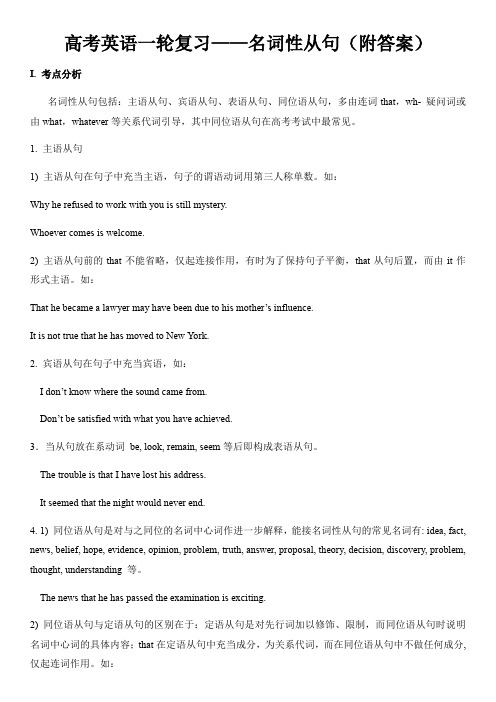
高考英语一轮复习——名词性从句(附答案)I. 考点分析名词性从句包括:主语从句、宾语从句、表语从句、同位语从句,多由连词that,wh- 疑问词或由what,whatever等关系代词引导,其中同位语从句在高考考试中最常见。
1. 主语从句1) 主语从句在句子中充当主语,句子的谓语动词用第三人称单数。
如:Why he refused to work with you is still mystery.Whoever comes is welcome.2) 主语从句前的that不能省略,仅起连接作用,有时为了保持句子平衡,that从句后置,而由it作形式主语。
如:That he became a lawyer may have been due to his mother’s influence.It is not true that he has moved to New York.2. 宾语从句在句子中充当宾语,如:I don’t know where the sound came from.Don’t be satisfied with what you have achieved.3.当从句放在系动词be, look, remain, seem等后即构成表语从句。
The trouble is that I have lost his address.It seemed that the night would never end.4. 1) 同位语从句是对与之同位的名词中心词作进一步解释,能接名词性从句的常见名词有: idea, fact, news, belief, hope, evidence, opinion, problem, truth, answer, proposal, theory, decision, discovery, problem, thought, understanding 等。
高考英语语法总复习之名词性从句课件
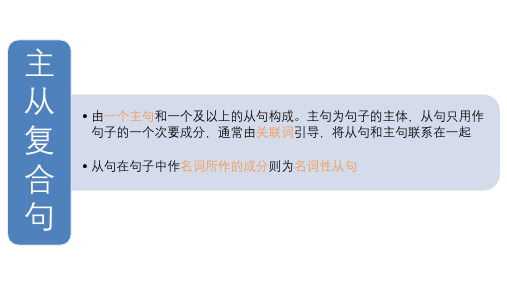
A. What
B. That
C. It
D. As
05. ______ is going to do the job will be decided in tomorrow’s meeting.
A. Which
B. That
C. What
D. Who
宾语从句
陈述
• that He believes that the earth is flat. ➢ that一般可以省略,但在如下情况则不能省
同位语从句
陈述
• that
The news that he has fallen in love has spread across the school.
疑问
• whether
I have no idea whether he’ll come or not.
• wh-/how(-ever)
It is a question how he will get a good score without memorizing words.
that
无意义,不作从句主干成分,在宾从中可省
I hear (that) he has joined the football club.
有意义,不作从句主干成分,不省略
I didn’t know whether/if he would attend the concert.
whether和if
两者区别
1) 并列几个宾语时,从第二个起不省 He believes (that) the earth is flat and that the sun turns around the earth. 2) 有插入语等其它成分干扰 He said, I remember, that he would help you, but…
专题8

高考总复习 ·英语
3.We must find out ________Karl is coming, so we can book a room for him.
【答案】when 4.—I wonder ________ Mary has kept her figure after all these years. —By working out every day. 【答案】how
高考总复习 ·英语
三、doubt的名词性从句
动词doubt
肯定形式 否定形式
使用whether/if引导名词性从句,如: I doubt whether it's true. 我怀疑它是否真实。 使用that引导名词性从句,如: I don t doubt that you are honest. 我不怀疑你的诚实。
高考总复习 ·英语
二、“疑问代词+ever”与“no matter+疑问代词”的 区别
分类 用法
whoever/whomever/whatever/whichever和no matter 相同点 who/whom/what/which都可用来引导让步状语从句,
此时两者可以互换
பைடு நூலகம்
不同点
whoever/whomever/whatever/whichever引导名词性从 句时不能与“no matter+疑问代词”互换
词起补充说明的作用,that只起引导作用,在从句中不充当任何成
分,但一般不能省略。
what
不可省略,在从句中作主语、宾语、表语、定语或补足语,有词义( 一般指……的东西/事情/人/时间/地点/话等)。
高考总复习 ·英语
【对点微测】 单句填空 1.The most pleasant thing of the rainy season is ________one can be entirely free from dust. 【答案】that 2.It is often the case ________anything is possible for those who hang on to hope. 【答案】that
高考英语语法复习:名词性从句
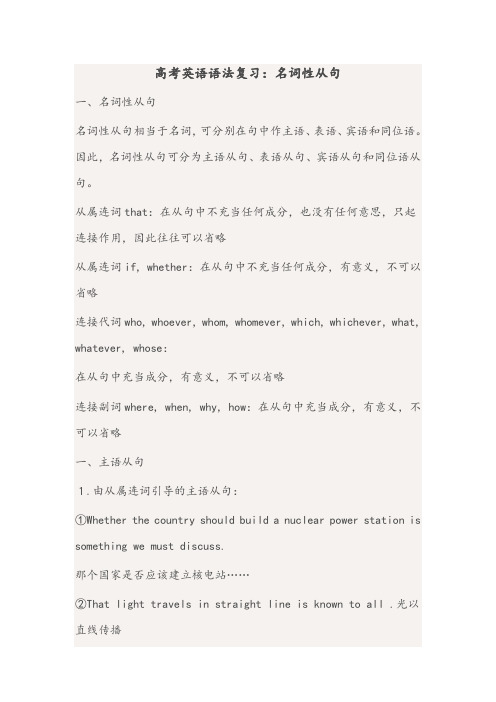
高考英语语法复习:名词性从句一、名词性从句名词性从句相当于名词,可分别在句中作主语、表语、宾语和同位语。
因此,名词性从句可分为主语从句、表语从句、宾语从句和同位语从句。
从属连词that:在从句中不充当任何成分,也没有任何意思,只起连接作用,因此往往可以省略从属连词if, whether:在从句中不充当任何成分,有意义,不可以省略连接代词who, whoever, whom, whomever, which, whichever, what, whatever, whose:在从句中充当成分,有意义,不可以省略连接副词where, when, why, how:在从句中充当成分,有意义,不可以省略一、主语从句1.由从属连词引导的主语从句:①Whether the country should build a nuclear power station is something we must discuss.那个国家是否应该建立核电站……②That light travels in straight line is known to all .光以直线传播2.由连接代词引导的主语从句:①What we need is more time. 我们所需要的是……②Whichever book you choose doesn’t matter to me.无论你选哪本书……③Whoever comes will be welcome.无论谁来……3.由连接副词引导的主语从句:①When the plane is to take off hasn’t been announced.飞机什么时候起飞……②Where he has been is still a puzzle.他到过哪儿……③How much water is flowing can be measured easily.水的流量是多少……4.关于形式主语it①It + be +形容词+ that-从句It is necessary that…有必要……It is important that…重要的是……It is obvious that…很明显……It is likely that….很可能②It + be + -ed 分词+ that-从句It is believed that…人们相信……It is knownto all that…众所周知……It has been decided that…已决定……③It + be +名词+ that-从句It is common knowledge that………是常识It is a surprise that…令人惊奇的是……It is a fact that…事实是……可应用于此句型的名词还有fact / shame / honor / question/pity等。
高考英语名词性从句知识点知识点总复习附答案

高考英语名词性从句知识点知识点总复习附答案一、选择题1.Craig is always sticking his nose in ______ it’s not wanted. He is always trying to find out my personal information.A.what B.which C.where D.that2.______ they have won the game made us excited.A./B.That C.What D.Which3.It is exactly ______ we behave ______has changed the world.A.which; that B.how; that C.how; what D.what; that 4.Then he told me _______ he was doing was very important.A.that B.that how C.what that D.why what5.I want to know _______.A.what matter it is B.what’s the matterC.what the matter is D.the matter is what6.Anyone who wants to can call any timepiece a clock, but technically speaking, only_________ ones ring out the time actually deserve the name.A.whatever B.whenever C.whichever D.wherever 7.They didn't discover until they happened to enter the back room _________ someone had stolen the priceless painting.A.that B.what C.which D.when8.When the news came ___ the war broke out , he decided to serve in the army.A.since B.which C.that D.because9.The Oscars have been around for so long that they serve as an indicator of ________ the Hollywood community values now and in the past.A.that B.where C.how D.what10.Anyone with common sense is able to make the proper decision and do ______ suits the occasion best.A.no matter what B.no matter how C.whatever D.however 11.Fanny asked ________ made that odd-looking little cat so popular.A.what was it that B.wat was thatC.what it was that D.what that was12._______football is such a simple game to play is perhaps the basis of its popularity. A.What B.Whether C.That D.Which13.He sold his house for twice ________ he paid for it so he did well out of the deal.A.how B.what C.that D.which 14.—Could you show me_____?—Sure.A.where is the library B.where the library is C.how can I go to the library 15.My grandmother helped me believe that I could accomplish ____________ I put my mind to. A.whenever B.whatever C.wherever D.whichever 16.Many experts stick to the view ______ teacher development is the key to the educationquality.A.which B.what C.that D.where 17.—What’s your understanding of success,Robert?—In my view,success is________preparation and chances meet.A.how B.why C.what D.where18.It was__ he said__ disappointed me.A.that;what B.what;that C.what;what D.that;that 19.The companies are working together to create ________ they hope will be the best means of transport in the 21st century.A.which B.that C.what D.who20.It is estimated that 12.79 million new urban jobs have been created this year, which almost doubles _____ it was last year.A.how B.which C.where D.what 21.Modern science has given evidence _________ smoking can lead to many diseases. A.what B.whichC.that D.where22.The exhibition tells us _____we should do something to stop air pollution.A.where B.whyC.what D.which23.(2016·天津)The manager put forward a suggestion __________ we should have an assistant. There is too much work to do.A.whether B.thatC.which D.what24._____we understand things has a lot to do with what we feel.A.Where B.How C.Why D.When 25.—Friends are very important for teenagers.—Yes. A friend will be listened to___________a parent or a teacher might not.A.where B.what C.why D.which【参考答案】***试卷处理标记,请不要删除一、选择题1.C解析:C【解析】【分析】【详解】考查宾语从句。
名词性从句高考复习

需要注意的,当主语是reason时, 表语从句要用that引导而不是 because。例如: The reason why he was late was that he missed the train by one minute this morning . 【点拨】whether 可引导表语从 句,但与之同义的if却通常不用于 引导表语从句。
注意:在demand、order、suggest、 decide、insist, desire, request, command等表示要求、命令、建议、 决定等意义的动词后,宾语从句常用 “(should)+ 动词原形”。例如: I insist that she (should) do her work alone. 我坚持要她自己工作。 The commander ordered that troops (should) set off at once. 司令员命令部队马上出发。
不可省略的连词: 1. 介词后的连词 2. 引导主语从句和同位语从 句的连词不可省略。 That she was chosen made us very happy. We heard the news that our team had won.
比较:
whether与if 均为"是否"的意思。 但在下列情况下,whether 不能 被if 取代: 1. whether引导主语从句并在句 首; 2. 引导表语从句 3. whether从句作介词宾语; 4. 从句后有"or not"
What he wants to tell us is not clear. 他要跟我们说什么,还不清楚。 Who will win the match is still unknown. 谁能赢得这场比赛还不得而知。 It is known to us how he became a writer. 我们都知道他是如何成为一名作 家的。 Where the English evening will be held has not yet been announced. 英 语晚会将在哪里举行,还没有宣布。
最新高考英语知识点总结总复习-名词性从句

专题九名词性从句题组1 宾语从句1.[2017北京,26]Jane moved aimlessly down the tree-lined street, not knowing she was heading.2.[2017江苏,26]We choose this hotel because the price for a night here is down to $20, half of it used to charge.3.[2015福建,29]—I wonder Mary has kept her figure after all these years.—By working out every day.4.[2015陕西,19]Reading her biography, I was lost in admiration for Doris Lessing had achieved in literature.5.[2015重庆,8]We must find out Karl is coming, so we can book a room for him.6.[2015四川,8]The exhibition tells us we should do something to stop air pollution.7.[2014福建,34]Pick yourself up. Courage is doing you’re afraid to do.8.[2013北京,33]Experts believe people can waste less food by shopping only when it is necessary.9.[2013新课标全国Ⅰ,26]Police have found appears to be the lost ancient statue.10.[2013山东,30]It’s good to know the dogs will be well cared for while we’re away.11.[2016甲卷(全国Ⅱ)改错]My classmates and I are talking about how to do during the holiday.12.[2015新课标全国Ⅱ改错]After looking at the toy for some time, he turned around and found where his parents were missing.题组2 主语从句13.[2017北京,23]Every year, makes the most beautiful kite will win a prize in the Kite Festival.14.[2016北京,24]Your support is important to our work. you can do helps.15.[2016江苏,21]It is often the case anything is possible for those who hang on to hope.16.[2015北京,35] we understand things has a lot to do with what we feel.17.[2015江苏,25] Li Bai, a great Chinese poet, was born is known to the public, but some won’t accept it.18.[2014大纲,24]Exactly the potato was introduced into Europe is uncertain, but it was probably around 1565.19.[2013四川,6] you said at the meeting describes a bright future for the company.20.[2013陕西,20]It remains to be seen the newly formed committee’s policy can be put into practice.21.[2013江西,30] one of you breaks the window will have to pay for it.22.[2013北京,31] makes the book so extraordinary is the creative imagination of the writer.题组3 表语从句23.[2016北京,29]The most pleasant thing of the rainy season is one can be entirely free from dust.24.[2015安徽,25]A ship in harbor is safe, but that’s not ships are built for.25.[2014浙江,8]"Every time you eat a sweet, drink green tea." This is my mother used to tell me.26.[2014北京,30]The best moment for the football star was he scored the winning goal.27.[2014江苏,26]—What a mess! You are always so lazy!—I’m not to blame, mum. I am you have made me.28.[2013安徽,21]From space, the earth looks blue. This is about seventy-one percent of its surface is covered by water.题组4 同位语从句29.[2016天津,11]The manager put forward a suggestion we should have an assistant. There is too much work to do.A组基础题A单句填空30.[2018江西赣州十四县市期中联考,67]All of a sudden, her handicap was gone and all I saw was this beautiful girl, whose smile just melted me and almost instantly gave me a completely new sense oflife is all about.31.[2018河南中原名校第二次质检,48]There is also new evidence green tea can help to destroy bacteria in our bodies.32.[2018上海光明中学开学考试,29]If the car travels 100 metres without the driver confirming their ID, the system will send a signal to an operations centre it has been stolen.33.[2018湖北宜昌示范高中协作体期中联考,66]One of the many benefits of the online classroom for students is they have the opportunity to interact (互动) on a regular basis with like-minded professionals from other countries and learn international business practices.34.[2018河南郑州外国语学校第四次调研,65]If they love each other, are committed to the relationship, and work on making it strong, that is counts.35.[2018安徽江淮十校第二次联考,48]War for the Planet of the Apes may not be the action and monster film that you had in mind, but it’s the kind of film that will make you want to sit in silence in the theater fora few minutes after it ends, taking in you’ve just w itnessed.36. [2017上海上海中学检测,36]Optimism and pessimism are both powerful forces,and each of us must choose we want to shape our future and our expectations.37.[2017广东广州期中考试,4] is known to us all is that the 2020 Olympics will take place in Tokyo.38.[2017浙江杭州第二中学期中考试,32]People are now eager to find out it is that the little boy survived the terrible disaster.39.[2016安徽六校联考,35]We have learned from the story that is most valuable is not what we have in our lives but who we have in our lives.B单句改错40.[2018河南南阳一中第三次考试改错]And that’s which I want to do: make a difference to them and let them know that people do care!41.[2018沈阳铁路实验中学月考改错]The reason for this is why I would like to share my knowledge with my students and help them solve problems.42.[2018贵州黔东南州第一次联考改错]He said he was from Birmingham and I was the only person who smiled and said hello to him all day.43.[2018广东珠海珠海二中、斗门一中期中联考]That the clerk said is true.44.[2018豫西南部分示范性高中联考]I’d appreciate it that you could be so kind to give me some useful advice.45.[2018湖北荆州第一次质量检测]It surprised me most was a 70-year-old runner beside me, who had been in for 92 competitions after his retirement!46.[2018湖南怀化期中联考]But the fact is what the fight is not over.47. [2017湖北四地七校高三联考]Recently the students in our class have had a heated discussion on if people should keep pets at home in cities.48.[2017辽宁东北育才中学高三模拟]I began to think about how I could do to help them.49.[2017 湖北襄阳高三一模]It has never occurred to me when I’ll become a doctor one day.50.[2017 江苏苏州高三调研]It is not necessary to explain the truth air, water and sunlight are vital for living things.51.[2016江西五市八校高三联考]And he asked his friend that the bear had whispered in his ear.B组提升题A专项语篇型填空(名词性从句)Experiences are acquired through our journey in life; we choose 1 we believe and 2 we look at things and people around us based on all our experiences in life. Despite the fact 3 things and life are the way they are, we all have different opinions and beliefs about everything and everybody. Other people have opinions about us as well. But 4 really matters is the opinion we have about ourselves. You choose to accept and follow what other people believe, but you can also decide 5 you want to become yourself and live according to the reality of life.By living life as it is and being yourself, you create an image about 6 you value most and 7 you admire most. You should remember 8 important it is to be yourself. The image that you create about yourself determines 9 you are and how you feel; it determines how successful you become in life and remind you 10 you are standing in life. In short, you are as happy or sad as you see yourself.B语法填空[2018江西赣州四校协作体期中联考]Before accepting a job offer,you should consider 41 the job is really what you want to do. Why are you interested in this position?The reason for 42 (take) a job mainly depends on your desires and your ability. It may be okay to take a job that is not something you 43 (real) want to do right now, if it allows you to get into a 44 (good) position in the future.Furthermore, you should consider the company 45 offers you the position. Is it a good company 46 (work) for? Does it share your values? If not, does this matter 47 you?One of the most 48 (satisfy) parts of a job for many people is that the job 49 (challenge) them. It allows them to think and focus on the solutions to 50 (problem).C短文改错[2018河北衡水中学联考]Today Mr. Zhang, our English teacher, told us what to improve our English writing skills. The ability to write in English is becoming increasing important in English communication as well as in examinations. Thus, it was worth focusing our attention.In order to write the good essay, we should have an excellent command of over 2,000frequently-used English word. It’s necessary and useful for them to read or even recite beautiful English articles. Beside, as the saying goes, that "Practice makes perfect", so we should take every possible chance to write in English.According my personal experience, keep a diary in English every day is a good means to achieve the aim.答案专题九名词性从句题组1 宾语从句1.where 句意:Jane漫无目的地沿着绿树成荫的街道往前走,不知道要去哪里。
- 1、下载文档前请自行甄别文档内容的完整性,平台不提供额外的编辑、内容补充、找答案等附加服务。
- 2、"仅部分预览"的文档,不可在线预览部分如存在完整性等问题,可反馈申请退款(可完整预览的文档不适用该条件!)。
- 3、如文档侵犯您的权益,请联系客服反馈,我们会尽快为您处理(人工客服工作时间:9:00-18:30)。
名词性从句综述名词性从句和名词一样,在句中可以担任主语、表语、宾语(动词宾语和介词宾语)和同位语。
因此我们说名词性从句包括主语从句、表语从句、宾语从句和同位语从句。
名词性从句必须用陈述句语序,也就是说, (疑问词) + 主语 + 谓语 + 其它.主语从句在复合句中作主语的句子称为主语从句, 从句作主语, 谓语动词用单数;通常由从属连词that, whether, 连接代词who, whose, what, which, whatever(无论什么), whoever(无论谁), whichever(无论哪个)或连接副词when, where, why, how等引导。
eg.1)* Whether we can reduce the use of energy is important.2)* That pollution has become a serious problem in parts of the world is known to everyone.3) What is needed is greater safety.4) Whoever breaks the rules must be punished.5)* How life began remains a puzzle to us.6) It is said that paper was first made in China.7) It seems that he is older.8) It’s certain that the sports meeting will be delayed.9) It doesn’t matter if you have no time to do it.注意:1. 陈述句必须以that 引导, 不能省略。
2. 主语从句只能用whether引导,不能用if引导。
3. 常用it作形式主语,代替真正的主语从句,但不能代替由what引导的主语从句。
4. 常用于It + be + adj. / n. / + that-clauseIt’s certain / clear / a pity /a fact/ common knowledge/ said / hoped …+ that / whether…It’s natural/ strange/ necessary/ important that… (should) …5.It doesn’t matter if 是固定句型。
6. 句型:It is required/ suggested/ insisted/ ordered …that…(should)+ do…7.that 与what的区别:that在从句中不充当任何成分,没有意思;what在从句中充当主语或宾语,意思是:…(所)…的Practice:他被选中了使我们很开心。
她是否有时间来还是个问题。
谁将被派去那儿还没有定下来。
我们所需要的是更多的时间。
他去了哪儿没人知道。
表语从句表语从句在复合句中作表语的名词性从句,放在系动词之后,一般结构是“主语+连系动词+表语从句”。
可以接表语从句的连系动词有be, look, remain, seem 等,也由that, whether, who, whose, what, which或when, where, why, how 等引出。
e.g. 1) My suggestion is that you (should) start it at once.2) What they want to know is whether they are right.3) That was how they were injured.4) My hometown is no longer what it used to be.注意:1. 陈述句由that引导,一般不省略;2. 疑问句只能用whether引导,不可用if 。
Practice:这正是我要的。
问题是这个工作是否值得做。
这就是他出生的地方。
那就是他为什么迟到的原因。
这就是他怎样做这件事的。
同位语从句在句子中作同位语的从句称为同位语从句。
同位语从句一般由连词that引导,常放在fact, news, idea, truth, hope, problem, discovery, information, word, message, thought, suggestion等名词的后面,说明该名词的具体内容。
eg. 1) The fact that he didn’t come shows that he has broken his word.2) Soon word came that they should announce the results of the exam.3) You have no idea how worried I was then.= You don’t know how worried I was then.注意:1. 同位语从句不同于定语从句,前者起补充说明作用,that是连词,在从句中不充当句子成分,不省略; 后者起修饰作用,that是关系代词(还可以由别的关系代词或关系副词引导定语从句),在从句中充当主语或宾语,作宾语时可省略。
e.g. 1) The news that they had won the battle soon spread over the whole country. ( 同位语从句)2) The news you told me yesterday was really disappointing. (定语从句)2. 同位语从句也可由连接代词who,which,what和连接副词where,when,why,how等引导。
The question who should do the work requires consideration.We haven’t yet settled the question where we are going to spend our summer vacation.It’s a question how he did it.Practice:我们已经听到了我们队赢了的消息。
他什么也没说这个事实使每个人惊讶。
他们没有他是否还活着的信息。
宾语从句在复合句中起宾语作用的从属句称为宾语从句。
1. 作动词的宾语(1) 由that引导的宾语从句(that 通常可以省略),例如:I heard that be joined the army.She suggested ( that ) he do it at once.(2) 由what, whether (if) 引导的宾语从句,例如:1) She did not know what had happened.2) I wonder whether you can change this note for me.(3) 动词+间接宾语+宾语从句。
例如:She told me that she would accept my invitation.2. 作介词的宾语Our success depends upon how well we can cooperate with one another. It depends on whether we will go.3. 作形容词的宾语例如:I am afraid (that) I’ve made a mistake.that 引导的从句常跟在下列形容词后作宾语:Anxious, aware, certain, confident, convinced, determined, glad, proud, surprised, worried, sorry, thankful, ashamed, disappointed, annoyed, pleased, hurt, satisfied, content 等。
也可以将此类词后的that 从句的看作原因状语从句。
4. It 可以作为形式宾语It 不仅可以作为形式主语,还可以作为形式宾语而真正的宾语that 从句则放在句尾,特别是在带复合宾语的句子中。
例如:We heard it that she would get married next month.We think it possible that the price will rise.注意:1. 关系词that常可以省略;2. 介词宾语用whether, 不用if;3. find / make / see / hear / feel / think… + it + adj. / n. + that …句型中, it 作形式宾语, that引导真正的宾语从句, 不能省;4. 若主句谓语动词为think, consider, suppose, believe, expect, fancy, guess, imagine等,其后的宾语从句若含有否定意义,一般要把否定词转移到主句谓语上,从句谓语用肯定式。
I don’t think (that) the film is interesting.I don’t think this dress fits you well. 我认为这件衣服不适合你穿。
5. be sure / certain / glad / afraid / sorry / pleased + that …句型中, that 可以省;6. what is / was the matter /wrong with sb作宾语从句, 不改变语序;Who knows what is the matter / wrong with him?7. 有两个或两个以上宾语从句时, 第二个和第二个以后的从句必须用that引导.She said she was pleased at her victory and that she would work harder. 另外,在名词性从句的复习过程中,我们还须特别注意以下问题:1.主语从句Whatever, whoever, whichever 引导的主语从句的区分。
whatever 相当于 anything that, 是 what 的强调形式,表示“无论什么”。
例如:Whatever she does is ridiculous.whoever 相当于anyone who, 是who 的强调形式,表示“无论谁;任何……的人”。
